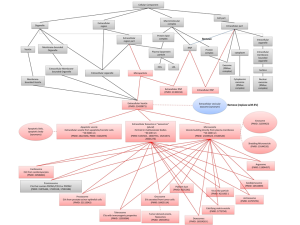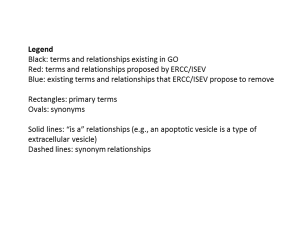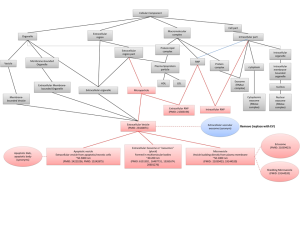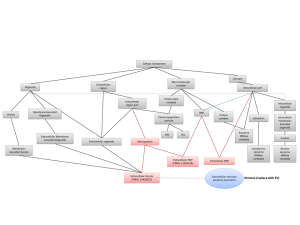The extracellular RNA communication program (ERCP) has established an ontology group to work towards standardization and classification of the terms used to describe extracellular vesicles (EVs). As part of this ontology subcommittee effort, we have worked with domain experts and ontology experts to propose new terms and relationships that can be added to Gene Ontology (GO) for describing EVs. Thus far, we have created three versions shown in Figures 1, 2 and 3 with different levels of detail (click on each figure for a higher resolution image).
In the most detailed version (Figure 1), each term (node) and relationship (edge) is required to have a minimal amount of evidence, potentially consisting of a single publication. As the knowledge evolves, some terms/relationships may be tentative, as in cases where the population of vesicles is heterogeneous and/or the biogenesis of the vesicles is uncertain. It is anticipated that there will be future revisions of the ontology structure (e.g., terms and relationships can be added, removed, and rearranged based on new knowledge). The main advantage of this approach is that it reflects the current state of the literature. Since it has more comprehensive coverage, including specific subtypes of EVs identified by subgroups of researchers, it can support more detailed annotation. The disadvantage, however, is that it is prone to changes. Some of the terms and relationships are likely to be revised in future iterations.
In the simplified/incremental approach (Figure 2 and Figure 3), each term and relationship must have strong evidence with a high level of community consensus to be included into the ontology. Because of the early stage of this field, using this approach, the current iteration of the ontology will include only terms that are quite general. It is anticipated that future iterations of the ontology will include additional terms for more specific types of extracellular vesicles/particles as they are better defined in terms of biophysical properties, functional characteristics, and macromolecular composition. The main advantage of this approach is the less anticipated need to remove or correct terms/relationships in the future. The disadvantage, however, is the lack of specificity in terminology limiting the ability to annotate datasets with precise terms.
We are in the process of building community consensus. We submitted our proposals to several consortiums and societies including the External RNA Controls Consortium (ERCC), International Society for Extracellular Vesicles (ISEV), and American Society for Exosomes and Microvesicles (ASEMV) for their review and approval. In addition, we will engage the broader community in the discussion.
The proposed versions of EV classification correspond to what we perceive as the lumper vs. splitter approaches. In the context of biological taxonomy, lumpers are those who prefer to classify organisms into larger groups based on substantial differences, resulting in fewer species overall, while the splitters prefer to use minute differences to classify living organisms into a greater number of separate groups. These two different approaches may not create significant conflicts for a well-understood domain. However, for a new or partially understood domain like extracellular RNA (exRNA) communications, it is difficult to decide which approach is better. Domain experts often contend vigorously about where the boundary ought to lie in terms of classification. For example, should there be separate terms for vesicles that are formed in endosomes/multivesicular bodies (sometimes termed exosomes) and vesicles that bud directly from the cell surface (sometimes termed microvesicles or shedding microvesicles)?
Finally, there are two major goals of the ontology subcommittee: i) publish a manuscript on the current considerations regarding the ontology of exRNA-containing particles, and ii) develop a recommended vesicle ontology to be submitted to Gene Ontology. We would like these documents to reflect the opinions of the exRNA community, so we need your input. Please post comments on the following questions, or send your thoughts to info@exrna.org:
What we have here is not a new debate. It is just another example of a classic argument between lumpers and splitters, one that may not be resolved any time soon. That lack of resolution is fine, because understanding grows from these debates. We should not be frustrated when scientists cannot agree with each other. Instead we should encourage their debates. New ideas and innovations are forged from debates, and are stronger because of them.
Which version of the three draft ontologies do you favor, and why? Specifically:
- Should there be separate terms for vesicles that are formed in endosomes/multivesicular bodies (sometimes termed exosomes) and vesicles that bud directly from the cell surface (sometimes termed microvesicles or shedding microvesicles)?
- How much literature support does a specific particle type need to be included in the ontology?
- Are there use cases associated with each version?


Figure 1. Most detailed version. Note that we have qualified the term Exosome, as Extracellular Exosome (as “Exosome” is already defined in GO for the intracellular protein complex)

Figure 2. Less detailed version.

Figure 3. Least detailed version.





